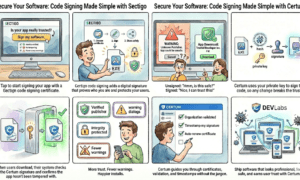In a world enamored with new technologies, legacy code remains the backbone of modern digital infrastructure. Rather than viewing it as outdated or burdensome, this article argues for embracing legacy systems as valuable assets. Drawing on expert perspectives from Michael Feathers and Martin Fowler, it highlights the importance of incremental refactoring, robust testing, and strategic modernization to ensure long-term software stability and growth.
As the world of software development continues to evolve, much of the conversation revolves around the latest technologies: AI-assisted coding, cloud-native refactors, and the ever-growing microservice movement. But despite the hype surrounding shiny new tools and paradigms, a quiet, powerful truth continues to shape the landscape of modern software: most of the world still runs on legacy code.
This code may not be glamorous. It may not be trendy. But it works. Whether you’re checking your bank balance, filing an insurance claim, or receiving a shipping update, chances are you’re interacting with a system built using older technologies like .NET 3.5, C++, or even VB6. These systems are maintained by dedicated teams, ensuring the wheels of digital life continue to turn smoothly.
Legacy Isn’t Old – It’s Hard to Change
Contrary to common belief, legacy code isn’t simply outdated or poorly written. More accurately, legacy systems are those that are difficult to change confidently-not because they lack tests entirely, but because their behavior is so deeply embedded, relied upon, or poorly understood that no one wants to risk altering it. Even making small changes can feel daunting, as it’s often unclear what unintended consequences might surface elsewhere in the system. Comprehensive end-to-end testing becomes challenging, and validating changes in production is risky and complex, further compounding the hesitation to touch the system.
Michael Feathers, in his book Working Effectively with Legacy Code, defines legacy code as “code without tests,” but in practice, the definition is broader. Even systems with some tests or documentation can feel like legacy when the consequences of a change are uncertain or the original design decisions are long forgotten. Similarly, Martin Fowler, in Refactoring, emphasizes evolving existing code incrementally rather than resorting to risky full rewrites. These perspectives reinforce that managing legacy systems is less about dealing with outdated technology and more about navigating deeply entrenched behaviors with care and discipline.
When engineers encounter legacy systems, the temptation is often to rewrite them entirely. New code feels cleaner, more modern, and easier to reason about. But complete rewrites are risky-they take years, often fail to deliver the anticipated benefits, and can introduce regressions or business disruptions. The most effective engineering teams recognize this and focus on carefully refactoring and evolving legacy systems rather than discarding them. Modernization isn’t about starting from scratch; it’s about improving what already works while preserving system stability.
How Smart Teams Handle Legacy Code
1. Characterize Behavior Before Changing It
When dealing with legacy code, the first step isn’t to start refactoring or deleting portions of code. Instead, great teams begin by understanding the system’s behavior. This might seem obvious, but all too often, engineers try to make changes without fully grasping what the existing code does.
The first step is often to write characterization tests that document how the system is expected to behave. These tests serve as a baseline, establishing the current functionality. Once these tests are in place, engineers can confidently proceed with refactoring, knowing exactly how the system should behave before and after the changes.
2. Write Tests Around Fragile Areas
Legacy systems are often fragile, containing areas where bugs are easy to introduce. These areas may have been written hastily, or they might be particularly sensitive due to their integration with other parts of the system. Identifying these fragile parts and writing tests for them is critical to preventing further issues.
By writing targeted unit tests and integration tests around these risky areas, engineers ensure that the fragile parts of the system are protected. This gives the team confidence that, when they make changes in the future, the system will continue to behave as expected. This approach builds a safety net, reducing the risk of introducing new bugs as the codebase evolves.
3. Refactor in Small Steps
Instead of attempting a massive overhaul, smart teams refactor in small, incremental steps. This ensures that engineers focus on a single class or function at a time. By isolating and cleaning up one piece of code, they can make changes without risking the stability of the entire system.
This incremental approach has two advantages: it allows the system to improve continuously without halting development, and it makes the codebase more maintainable over time. The small improvements stack up, and the system becomes more robust and reliable with each sprint.
4. Use Safe Wrappers, Adapters, and Controlled Rollouts
One powerful strategy for handling legacy code is to wrap it with new functionality rather than directly modifying it. If certain parts of the code are too brittle or risky to change, wrapping them in adapters or safe wrappers can create a protective layer.
This approach allows teams to introduce new functionality around the old code, ensuring the system can evolve without jeopardizing the stability of its core components. Wrappers and adapters act as buffer zones, isolating legacy behavior from new logic and enabling teams to build on top of what already works without breaking existing functionality.
Equally important is how changes are rolled out. Even with safe wrappers in place, introducing new behavior gradually reduces risk. Feature flighting (or feature flags) is a key technique here: by gating new functionality behind configurable flags, teams can enable changes for a small subset of users, carefully monitor system behavior, and incrementally increase exposure. This controlled rollout approach allows issues to surface early, minimizes blast radius, and ensures a smooth, confident deployment to production.
By combining safe wrappers with flighted releases, teams can modernize legacy systems thoughtfully-balancing innovation with stability.
Navigating Complexity: My Experience with Legacy Systems
Early in my career as an engineer, I worked extensively on Microsoft Exchange Server’s Cloud Cache service, which manages client access to third-party and on-premises Exchange mailboxes in the cloud, as well as the Mailbox Replication Service, responsible for syncing content from external email systems into cloud cache mailboxes.
One memorable challenge emerged during the integration of Monarch (the new Outlook client) with cloud cache mailboxes, primarily used by Gmail users. When Google mailboxes were added as cloud caches in the Outlook Monarch client, we encountered a complex issue: both Outlook and the Cloud Cache system were independently generating sent items. One copy of an email would move from the Outbox to the Sent Items folder, and another copy-synced from the third-party mailbox via Cloud Cache service-would also appear in the Sent Items folder. This redundancy led to duplicate sent items, complicating synchronization and degrading the user experience.
Because both systems-Outlook’s native design and the Remote Send functionality-were deeply integrated and difficult to modify independently, we had to engineer a solution that harmonized the behavior across both architectures. This demanded careful, intricate work to prevent duplication while preserving system integrity.
Working on Exchange taught me firsthand what it means to deal with legacy systems. Exchange is configuration-heavy, tightly coupled with Active Directory, and central to enterprise communication. Every change carries weight. Refactoring wasn’t just a matter of writing new code-it meant examining one script at a time, respecting the system’s history, and making deliberate, cautious improvements.
My experience wasn’t just about maintaining existing functionality; it involved debugging new code, reverse-engineering undocumented behaviors, and resolving complex issues—all while safeguarding a global, business-critical infrastructure.
This work taught me a fundamental lesson: working with legacy systems isn’t about aggressively trying to “fix” them. It’s about understanding their evolution, appreciating their complexity, and thoughtfully improving them while safeguarding what already works.
Legacy Code Isn’t Going Away – And That’s a Good Thing
Startups may enjoy the luxury of greenfield development, but as companies scale-even modestly-they inevitably inherit legacy code. Every product decision, every workaround, every bug fix becomes part of the historical fabric of the system.
In industries like finance, healthcare, logistics, and government, legacy systems aren’t just old-they’re valuable assets. These systems encapsulate years of business logic and real-world experience that cannot be easily rebuilt. Legacy code has survived the test of time, and in many cases, it still supports millions of users every day.
The Future Rests on the Past
New technologies, frameworks, and methodologies will continue to emerge. However, the future of software development will be shaped by the way teams manage and modernize legacy codebases, not by the tools they use to start from scratch.
Legacy code isn’t a burden. It’s the starting point for the next decade of reliable, scalable software. By embracing it, understanding its history, and modernizing it incrementally, we can build upon the strong foundation that legacy systems provide. In the end, the most successful teams will be the ones that respect the past while building for the future.
Legacy code is the backbone of modern software. It’s not going anywhere, and that’s exactly why we should embrace it.
References
Michael Feathers, Working Effectively with Legacy Code (Prentice Hall, 2004)
Publisher’s page: https://www.pearson.com/en-us/subject-catalog/p/working-effectively-with-legacy-code/P200000008984/9780131177055 Pearson
Steve McConnell’s Code Complete: A Practical Handbook of Software Construction (2nd Edition, 2004):
https://www.amazon.com/Clean-Code-Handbook-Software-Craftsmanship/dp/0132350882 Amazon
Roman Shvets, “Why Legacy Code Is Still the Backbone of the Software Industry,” TechCrunch (2020)
































